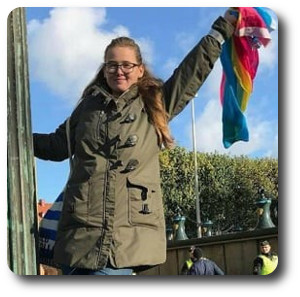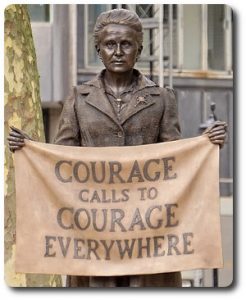 ‘I heard these words somewhere and wrote them down’ said Trudy* at our session today, ‘I keep the piece of paper on the arm of the chair I like to watch TV in-I’m not ready to throw it away yet’.
‘I heard these words somewhere and wrote them down’ said Trudy* at our session today, ‘I keep the piece of paper on the arm of the chair I like to watch TV in-I’m not ready to throw it away yet’.
I felt that these words, ‘a small courage has taken hold of me’ summarised the session perfectly as Trudy* had described her own small acts of resistance in disentangling herself from a longstanding unhappy relationship. I have used many NVR principles in my work with Trudy*, and noticing her small acts of resistance in setting limits for herself around what she is prepared to tolerate within this relationship has been key to the therapy.
Trudy* told me stories of her transformation which are remarkable in their power and simplicity and which capture the innate need of human beings to protest and resist. Trudy* wanted me to know that she is going to spend money on her own interests, interests which she had long buried to accommodate the wishes of the man she was with. She has tickets to a concert by a musician she admires but has never been to see because of her partner’s disapproval; she is buying a pair of expensive shoes she would have been ridiculed for indulging in; she is going to see friends in another area of the country and has plans to visit a part of the coastline described in a poem by her favourite poet, which means much to her but was diminished by her partner. I like to view it as Trudy* is coming home to herself.
I have been thinking about the history of defiance for some time. As an NVR practitioner, it is a central concern to assist parents in  finding their own courage to protest and disobey. Gene Sharp, possibly the foremost scholar of Non-Violent Action, details the history of the movement in his book ‘Power and Struggle’ (Extending Horizons Publishing, 2012). He notes that much of the long history of non-violent struggle has not been documented due to a lack of interest (I wonder too if this is also because those protesting did not generally get to be the chroniclers of history).
finding their own courage to protest and disobey. Gene Sharp, possibly the foremost scholar of Non-Violent Action, details the history of the movement in his book ‘Power and Struggle’ (Extending Horizons Publishing, 2012). He notes that much of the long history of non-violent struggle has not been documented due to a lack of interest (I wonder too if this is also because those protesting did not generally get to be the chroniclers of history).
However, he finds beautifully rich examples which date it back at least to ancient Rome: ‘In 494 BC, the plebeians of Rome, rather than murder the consuls in an attempt to correct grievances, withdrew from the city to a hill…There they remained for some days, refusing to make their usual contribution to the life of the city. An agreement was then reached pledging significant improvements in their life and status.’ Sharp also comments that ‘the power relationship exists only when completed by the subordinate’s obedience to the ruler’s demands and compliance with his wishes’.
I am inspired and delighted when I read of such things, as I can connect my work with Trudy (and my other clients) to an ancient human trait- disobedience! Such playful creativity is possible then in circumstances which normally seem only bleak. It calls to mind the mother who took great delight in telling me that she had reclaimed the front seat in the family car ‘I’m in the driving seat, Jill’ she laughed. This from a woman whose young son attempted to control every facet of her life, including where she could sit.
It connects too with a current of resurgent public interest in nonviolent protest and ways of objecting (perhaps a sign of the  times we are living through, with a global growth of right-wing populist and authoritarian political regimes). There is currently an exhibition on at the British Museum and curated by ‘Private Eye’ editor, Ian Hislop, about the evidence of dissent in the Museum’s collection. Entitled ‘’I Object’ (see what he did there?), the oldest exhibit is an Assyrian brick defaced by its maker. As Hislop explains: ‘All these bricks had to have the king’s name on them, but one brick-maker decided that over the top of the official stamp of Nebuchadnezzar he would scrawl his own name, Zabina. He then put the brick into a wall and thought that his small act of defiance would never see the light of day. But now thousands of years later, the wall has fallen down, and the brick has ended up in the British Museum’. Hislop comments that he finds this very cheering, as do I. As he says, it is a case of ‘Look upon my work you not very mighty and take heart!’.
times we are living through, with a global growth of right-wing populist and authoritarian political regimes). There is currently an exhibition on at the British Museum and curated by ‘Private Eye’ editor, Ian Hislop, about the evidence of dissent in the Museum’s collection. Entitled ‘’I Object’ (see what he did there?), the oldest exhibit is an Assyrian brick defaced by its maker. As Hislop explains: ‘All these bricks had to have the king’s name on them, but one brick-maker decided that over the top of the official stamp of Nebuchadnezzar he would scrawl his own name, Zabina. He then put the brick into a wall and thought that his small act of defiance would never see the light of day. But now thousands of years later, the wall has fallen down, and the brick has ended up in the British Museum’. Hislop comments that he finds this very cheering, as do I. As he says, it is a case of ‘Look upon my work you not very mighty and take heart!’.
We can all feel very defeated at times by the scale of the challenges presented by the families we work with. I find that these examples of small acts of defiance are an inspiration to keep going and to think of human beings as naturally resistant- our job is to find these chinks of hope and to amplify them and expand the possibilities for further action.
Another recent example of defiance to cheer us all on was reported in the Guardian newspaper (and across social media and the internet). As the guardian reported: ‘A lone student activist on board a plane at Gothenburg airport has prevented the deportation of an Afghan asylum seeker by refusing to sit down until the man was removed from the flight.
Her successful protest, footage of which spread rapidly across the internet, shines a spotlight on domestic opposition to Sweden’s tough asylum regime, at a time when immigration and asylum are topping the agenda of a general election campaign in which the far right is polling strongly.
“I hope that people start questioning how their country treats refugees,” stated Swedish plane protester Elin Ersson 21, in an interview with “The Guardian” newspaper. “We need to start seeing the people whose lives our immigration [policies] are destroying.” The social work student at Gothenburg University bought a ticket for the flight from Gothenburg to Turkey on Monday morning, after she and other asylum activists found out that a young Afghan was due to be deported on it. In fact, he was not on the plane, but activists discovered another Afghan man in his 50s was onboard for deportation.
interview with “The Guardian” newspaper. “We need to start seeing the people whose lives our immigration [policies] are destroying.” The social work student at Gothenburg University bought a ticket for the flight from Gothenburg to Turkey on Monday morning, after she and other asylum activists found out that a young Afghan was due to be deported on it. In fact, he was not on the plane, but activists discovered another Afghan man in his 50s was onboard for deportation.
As she entered the plane, Ersson started to livestream her protest in English. The video received more than 4m hits. Facing both sympathy and hostility from passengers, the footage shows Ersson struggling to keep her composure.
“I don’t want a man’s life to be taken away just because you don’t want to miss your flight,” Said Errson.
“I am not going to sit down until the person is off the plane.”
Repeatedly told by a steward to stop filming, Ersson said: “I am doing what I can to save a person’s life. As long as a person is standing up the pilot cannot take off. All I want to do is stop the deportation and then I will comply with the rules here. This is all perfectly legal, and I have not committed a crime.”
When an angry passenger, who appears to be English, tries to seize her phone, she tells him: “What is more important, a life, or your time? …”
“I want him to get off the plane because he is not safe in Afghanistan. I am trying to change my country’s rules, I don’t like them. It is not right to send people to hell.”
After a tense standoff, during which the airport authorities declined to use force to eject Ersson, passengers broke into applause when the asylum seeker was taken off the plane.’ (Guardian report 26.7.18)
Social media gives us many more opportunities for creative means of documenting these small but hugely significant acts of disobedience. Perhaps we will have a richer history of nonviolent action as a result.
On a final note, as I was walking through central London just last weekend I reflected on the number of monuments and museums dedicated to chronicling battles, war, and military leaders. I wondered, What would our civic spaces be like if they contained more statues like that of the suffragist Millicent Fawcett. Millicent campaigned (non-violently – as she was not a suffragette) for a women’s right to vote during the early 20th Century and is seen as one of the most influential feminists of the past 100 years. ‘Courage calls to courage everywhere’ is the banner she holds.
Let’s continue as NVR practitioners to highlight and document all the small acts of courage demonstrated by our clients in taking back space in their homes and in their lives, protesting against injustice and violence.
*Names have been changed to protect privacy
Jill Lubienski
Systemic Psychotherapist & Social Worker

